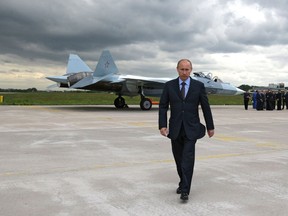David J. Bercuson: How Russian President Vladimir Putin is keeping NATO alive
The harder he pushed, and the more vigorously Russia toed a hard line, the more that many European countries — and Canada — began to push back

Article content
United States President Donald Trump may be doing his best to render NATO irrelevant and certainly to undermine traditional American alliances with European allies, but Russian President Vladimir Putin appears to be doing his best to save it.
Putin believes that NATO is a great threat to Russia and its ambitions and has publicly mourned the downfall of the Soviet Union as the greatest tragedy of the 20th century. No one knows better than he does the military and diplomatic solidarity that bound NATO together from its founding in 1949 to the end of the Cold War, during which it achieved its objective of containing Soviet Russia. During that period of 40-plus years, no European territory fell under Soviet influence because the United States’ nuclear umbrella and Article V of the NATO treaty (an attack against one is an attack against all) simply posed unacceptable risks to any Soviet leader who may have been tempted to slice off Western Europe a piece at a time.
When the Cold War ended in 1989/90, NATO’s chief reason for existence disappeared almost overnight. The United States and its allies were torn about NATO’s future even as old Soviet Bloc allies such as Poland, Hungary and Romania broke away from the now defunct U.S.S.R. and sought membership in NATO, usually as a half-way measure to joining the European Union.
Cracks began to appear in NATO in the 1990s as the U.S. bore down on the regime of Saddam Hussein, which, it asserted, was manufacturing weapons of mass destruction. When the U.S. attempted to enforce a ”no fly” zone over Iraq in the mid- to late-1990s, the British stuck with the United States but France and Germany did not. And when NATO intervened in the Balkans to stop ethnic cleansing in Kosovo by Serbia with a bombing campaign in 1999, NATO was seriously divided over taking such action with some NATO members refusing outright to join the campaign.
As the economies of eastern and western Europe began to merge in the early 2000s, NATO’s members — including Canada of course — cut their defence spending to the point where the United States was shouldering the great bulk of the burden of carrying NATO. NATO did show up after the 9/11 terrorist attacks against the United States, but the restrictions that NATO members placed on their military contributions to the war against the Taliban in Afghanistan made concerted military action very difficult.
Along came Donald Trump in 2016 to berate NATO members for not doing their fair share and threatening to pull the United States out of NATO.
Whatever the real relationship between Trump and Putin may be, Putin continued to push back against NATO and used military intervention in Georgia and Ukraine to ensure that non-NATO countries in Europe got the message to stay away from NATO and the European Union for that matter. And the harder he pushed, and the more vigorously he toed a hard line, the more that many European countries — and Canada — began to push back.
NATO has serious problems today, no one should doubt. Perhaps the most serious is the rise of nationalistic hard-right governments in Hungary, Italy, Poland, Greece and other countries. For example, Turkey has become a significant outlier in NATO and no one can be sure where it will find itself in the next decade.
At the same time most European countries either are increasing their defence budgets or have recorded their intentions to do so. Canada has been coasting along spending from 1-1.2 per cent of its Gross Domestic Product for the better part of a decade, but the White Paper on Defence — Strong, Secure and Engaged — issued in 2017 promised to raise Canadian defence spending to 1.4 per cent of GDP. In total, European members of NATO have added more than $50 billion to their defence budgets since 2015. That is almost twice the Canadian defence budget today.
Canada and other NATO allies have sent troops to eastern European and Baltic countries to act as trip wires in the event of Russian military aggression. And there is now renewed interest in France and Germany in a “European Army,” not a new idea but one that if seriously pursued would add significant power to NATO’s European arm.
The NATO of today is a shadow of NATO during the Cold War, but although relations between Russia and the U.S. are at rock bottom, we are not yet in a new Cold War and not likely to be in one anytime soon. Not when Germany is buying natural gas from Russia and cyber attacks are fast becoming the principal means of waging modern war. Nevertheless, if Putin keeps pushing, NATO will continue to strengthen. There is much irony there.
National Post
David J. Bercuson is a fellow of the Canadian Global Affairs Institute and director of the Centre for Military, Security and Strategic Studies at the University of Calgary.











Postmedia is committed to maintaining a lively but civil forum for discussion. Please keep comments relevant and respectful. Comments may take up to an hour to appear on the site. You will receive an email if there is a reply to your comment, an update to a thread you follow or if a user you follow comments. Visit our Community Guidelines for more information.